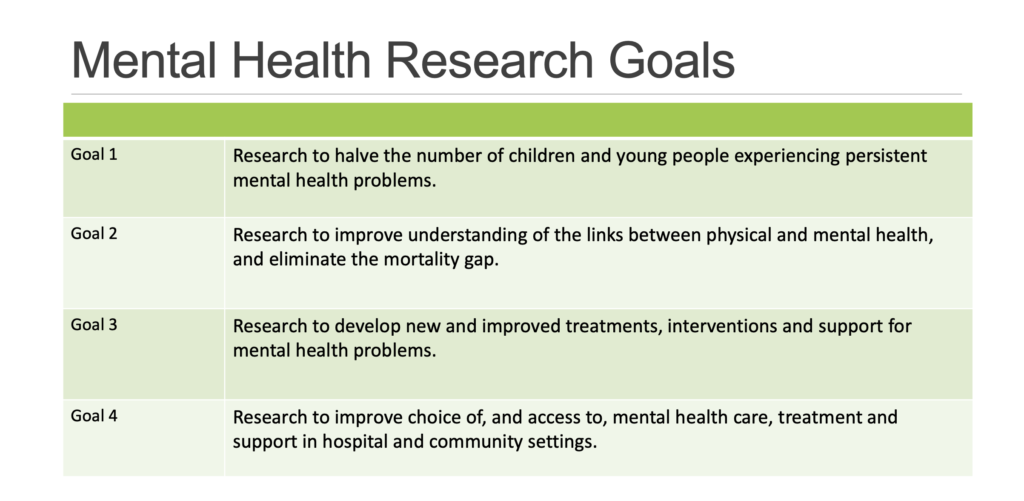
Mental health research has been under-funded in relation to global burden of suffering and little has changed despite words from governments and funders alike (e.g. Kingdon and Wykes 2013, MQ Mental Health 2019).
All researchers also think that their area of research is vital and should have more investment. But is this true or do we just think our topic is the Cinderella one?
Analyses of mental health research funding has rarely crossed geographical borders and is often from a single funder and so provides little evidence of what is funded or where funded research is carried out. This information may help funders (and researchers) to understand the balance of investment – we may be surprised by the answers. This project explores mental health research funding data from across the globe to provide this baseline (Woelbert et al, 2020).

We need information on global mental health research investment before we can decide how it should be spent.
Methods
There are few comprehensive databases that hold information on funders, the investment and the type of research, but the authors used the Dimensions database from 2015-2019. It has data from 500 global funders and 5.4 million searchable grants. The authors supplemented these data with a call to mental health funders to submit or update their data to this database. They defined mental health research to cover bio-psycho-social approaches and normal psychology approaches to cognition and behaviour.
Extracting mental health grants
- The authors used different machine algorithms held within the Dimensions database to identify mental health research
Categorising the funded research
- There were 17 condition-specific categories and two others. Anything not allocated was included in a non-disease specific category
- There were 8 top level codes for the type of research along the translational pipeline
Multiple checks on data quality, especially extraction accuracy
The authors performed a review of:
- A random sample of extracted data (N=325)
- Data from known mental health funders (N=835)
- A selected sample from non-English speaking countries (500 grants)
Other data
- Funding amounts as the in-year spend e.g. if for 5 years then the total is divided by 5
- World Bank defined high or low- and middle-income countries (HICs and LMICs)
- Funder type as government/public, philanthropy, or fundraising charity
Results
Some data were inevitably missing, but the authors found 75,956 mental health grants active between 2015–19 from 345 funders in 38 countries. Mental health represented about 4% of all registered grants (75,956 grants) and 4% of the total research investment (USD 18.5 billion). Most investment was in high-income countries (89%), with the USA funding 39% of all grants. Although only 11% came from low and middle income (LMIC) based funders this is an under-estimate of the in-country funding, as institutions in LMICs, especially on the continents of South America and Africa, received funding via high income countries. Most investment (90%) came from public sources with differences between countries in philanthropic and fundraising charity investment. All these investments seemed static over the years studied.
As expected, most grants were “non-specific” and the next categories in number of grants and spend was substance misuse (18.9%) and depression (18.6%). Under-pinning research and prevention (i.e. the basic part of a translational pathway) took the largest slice of funding with 56% of investment in these areas. The categories of prevention, detection, developing treatments, clinical trials, management of disease, and health services research received only 24% altogether.
The accuracy of the data differed depending on the checking method. The precision was highest (99%) when only known mental health funders were considered, when a random sample was reviewed it was 76% and when considering global Non-English speaking funders it was only 67%.

Only 4% of research grants and funding worldwide was allocated to mental health research.
Conclusions
Mental health research funding is too little, sometimes in the wrong places, and too much of the meagre investment is on basic research (i.e. research carried out in laboratories to provide a biological understanding of how mental health difficulties emerge and some potential treatment targets) in terms of resources and the number of grants. It is heartening to have your mindset supported by data. This provides us with the ammunition for discussions with governments and funders about the focus of future research investment. These sorts of data would also enable us to track how the funding landscape has changed and where more pressure might help shift it.

We have the research funding data to help change the funding landscape – so, what are we waiting for?
Strengths and limitations
There are few studies on the use of research funding. Others have provided similar results within countries or across just a few countries (e.g. Hazo et al, 2017), but this study provides a global impression. Data quality, as acknowledged by the authors, is not very high and particularly with those funders from non-English speaking countries. Most algorithms extracted similar numbers of grants, but only 53% were extracted by all the methods. So, the results may depend on which algorithm was used. When abstracts were provided, the accuracy of the algorithms increased, but of course they need to become more sophisticated. More funders need to be encouraged to submit and to submit just a bit more text.
But more importantly, there is a problem with equating research investment with research effort. Different studies require different levels of resources, and research efforts in different countries for the same study differ in cost. Basic research is more expensive because of the laboratory maintenance and the equipment expense e.g. MRI scans. On the other hand qualitative research is cheaper as it requires less equipment, and the main cost is the staff. In addition, some laboratory research on genes may cost less to implement in Zimbabwe than in the USA. Using grant numbers, not cost, is therefore much more useful.

Does research funding = research effort? We need to be smart about the way we invest in mental health research.
Implications for practice
We now know how funders spend their resources and that the main ones are in the public sector. Many research priority exercises have been produced and some have had an impact on general funding arrangements (e.g. Wykes et al, 2015; James Lind Alliance). But they are not accepted by all funders. We also need to answer some harder questions. For instance, we need basic research, but do we need this much of it? We could expand the definition to include research into psychological, social, and structural factors. There are currently clear gaps – children’s mental health, improving treatment worldwide, changing supports and eliminating the mortality gap. Working towards clear goals may shorten the time to impact from whatever field of mental health research. An accepted framework for guiding investment with time points for assessing achievement would help to shift funding. We have produced one for the UK, which may be the starting point for other countries (Wykes et al., in press).

Mental health research funding gaps include youth mental health, improving treatment worldwide, changing supports and bridging the mortality gap.
Statement of interests
I am a clinical psychologist with an interest in how research funds are spent. I was the first author of the largest report on priorities and have recently been involved in the production of four mental health goals.
Links
Primary paper
Eva Woelbert, Kierstin Lundell-Smith, Rory White, Danielle Kemmer, (2020). Accounting for mental health research funding: developing a quantitative baseline of global investments, The Lancet Psychiatry, ISSN 2215-0366.
Other references
Hazo JB, Gandré C, Leboyer M, et al. National funding for mental health research in Finland, France, Spain and the United Kingdom. Eur Neuropsychopharmacol 2017; 27: 892–99.
Kingdon D and Wykes T (2013) Increased funding needed for mental health research. BMJ 2013; 346.
Wykes T., Bell A., Carr S., Coldham T., Gilbody S., Hotopf M., Kabir T, Pinfold V., Sweeney A., Jones PB and Cresswell C. Shared goals for mental health research: what, why and when for the 2020s. Journal of Mental Health 2021 (in press)
Photo credits
- Photo by Jp Valery on Unsplash
- Photo by Christine Roy on Unsplash
- Photo by Karim MANJRA on Unsplash
- Photo by Austin Chan on Unsplash
- Photo by Dylan Gillis on Unsplash
- Photo by Etty Fidele on Unsplash

